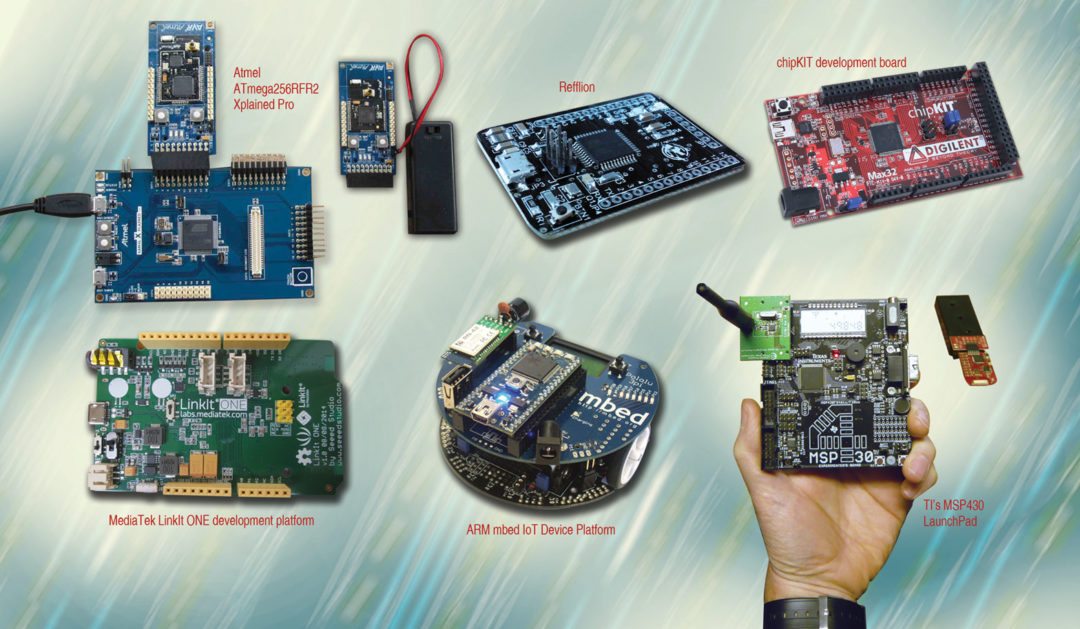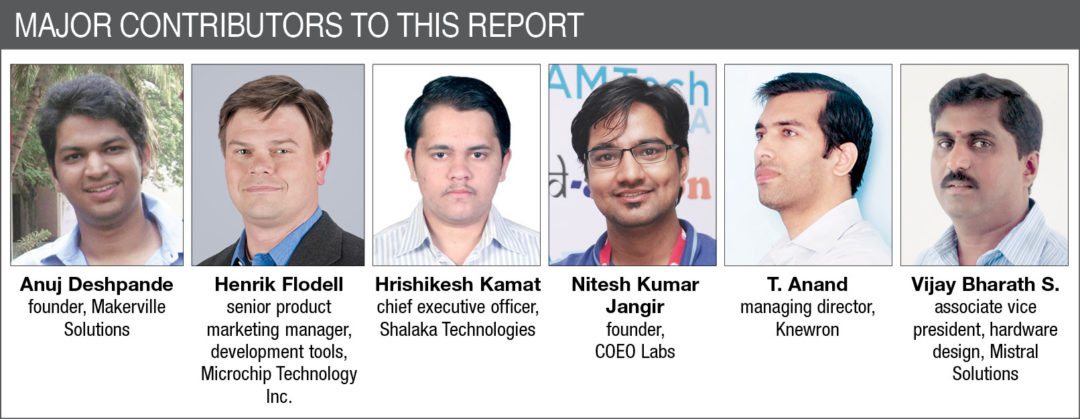Using development boards to design a device makes the job simpler. While selecting the board, go for one that requires minimum changes for your application. However, for intense applications, something a little more specific would be a better solution.
Development boards have become extremely useful for designers. Nitesh Kumar Jangir, founder, COEO Labs, and Vijay Bharath S., associate vice president, hardware design, Mistral Solutions, agree that use of development boards during prototyping stage of a product is of huge help.
Developers often go for custom boards to develop solutions for their specific uses, or commercial purposes, after testing these out on a regular reference board. Let us take a look at some of the solutions that could come handy the next time you decide to design a product.
Why application focus
Once you decide to go with a special board, you look into what it offers. On close inspection, we can see some stark differences. “Reference designs are very time to market,” adds Anuj Deshpande, founder, Makerville Solutions. Bharath also agrees on the issue of turnaround time.different,” says Henrik Flodell, senior product marketing manager, development tools, Microchip Technology Inc. “The goal here is to deliver something that is 80 per cent to 90 per cent complete.”
The board for wearable design would be small in size, without compromising on performance in order to fit maximum peripherals onto the board. But the board for audio-video processing would have heavy data-processing capabilities. Similarly, the board focused towards the Internet of Things (IoT) application development would focus on connectivity and would be very power-conscious.
Suppose, you went with a general-purpose board for your product. You would have to add several shields on top of it to improve performance and to incorporate some features. “This can be overcome with application-focused development boards,” says Hrishikesh Kamat, chief executive officer, Shalaka Technologies. “There are highly specialised boards with specific applications or use cases in mind,” adds Flodell. Kamat explains, “Now, we do not need to add shields and can design more elegant aesthetics as well.”
Developing the final solution without going through the hassle of a separate board, would be a welcome change. “This would also bring down the bill of materials significantly,” says Jangir. “Components are as per requirement and the number of unnecessary peripherals is reduced,” adds T. Anand, managing director, Knewron. “These small features would eventually help in faster time to market,” adds Anuj Deshpande, founder, Makerville Solutions. Bharath also agrees on the issue of turnaround time.
A look at some development boards
“With reference boards the motive is to provide support for maximum solutions. Intensive programs might not work due to either software development kit not being up to the challenge or memories being insufficient,” says Bharath. Deshpande adds, “In a general-purpose board, many controls are automatic, which is not the case with a focused solution.”
Development boards are available for a very wide range of applications ranging from music processing to agriculture. Suppose, we require a solution for wireless connectivity without power consumption of Wi-Fi, we have Pinoccio board to get the job done. “This simplifies a lot of things and allows working with the device aesthetics as well,” adds Anand.
As per Flodell, “Certification of equipment according to numerous international standards directives is very important.”
Wireless connectivity focus
Crowd-funded Pinoccio development board has Atmel ATmega256RFR2 at its core. Pinoccio is a wireless, Web-ready microcontroller board packed with Wi-Fi, lithium-polymer battery and built-in radio. Each unit can communicate with one another using a mesh network for easy connectivity.
SmartWiFi module from Knewron is another example of a wireless-focused board currently available. Connectivity is being prioritised in product development today and such solutions come in handy. Winkel board offers another alternative by offering WiFi, Bluetooth, 2.4GHz ISM and an RTC on the same board. It’s compatible with Arduino and is usable without different shields for different tasks.
Connectivity solutions are also available through various other boards. However, incorporation of a multitude of other peripherals makes these suitable for do-it-yourself and not so much for product development.
Incorporating Wi-Fi into a solution requires going for a custom board, which brings in several other factors. “Small form factor and ease of integration have been crucial factors with SmartWiFi,” says Anand.
A wireless Arduino with a 0.8km (half-mile) range would be an interesting addition to these solutions. Flutter lets users develop mesh networking protocols and connect various devices. Wireless applications can range from robotics, consumer electronics and wireless sensor networks to educational platforms. Flutter is packed with Atmel SMART SAM3S Cortex-M3 processor, while for security it has ATSHA204 crypto engine.

Connectivity in small size: wearable/IoT
Development boards for the IoT and wearables have undergone the most refinement. Today these are so highly optimised, you can prototype on a board. And if you find any feature unsuitable for your applications, you would find another that meets all your specifications, hence, reducing bills of material and time to market. So the area that requires developers’ attention the most is efficient software-hardware integration.
Extensive use of sensors has also been a boon for IoT applications. Apart from being used in custom projects, now miniature sensors are being used for almost everything. Metaware boards from Mbientlabs are one such example.
Popularisation of the IoT and wearables has lead to huge adoption of wearables and, in turn, demand for development boards that suit the applications. With sensors like activity detection, temperature measurement, compass and gravity, among others, these come in quite a small package, for easy applicability in healthcare, fitness, commercial and industrial wearables.
To develop wearables and connected IoT nodes, Thunderboard Wear is a possible solution. The demo board is based on ARM mbed wearable reference design and features Silicon Labs’ EFM32 Giant Gecko along with Bluetooth Smart connectivity. It includes an onboard USB programmer and debugger, and has external connections for real-time energy profiling through Simplicity Studio.
UDOO is another platform solution for Android, Linux, Arduino and Google accessory development kit 2012. Built upon ARM Cortex-A9 CPU and Atmel SMART SAM3X8E ARM Cortex-M3 CPU, it provides a flexible environment that allows you to work with the IoT development. Replacing the microSD card and rebooting the system allows switching between Linux and Android.
Connectivity is being prioritised and we will always have multiple products to take care of it. Let us take a look at some solutions suitable for other applications as well.
Help in healing
Equipment design for medical purposes is an extremely sensitive matter and, hence, we do not see many pre-built solutions in this field. The field requires very high precision and safety; even slight miscalculation can lead to very disastrous results. However, there are solutions available for the prototyping stage. Jangir explains the types of requirements from the equipment design perspective. “Wearables, therapeutic equipment and diagnostics can be the broad categorisation of the type of equipment designed,” he says.
“We use development boards during prototyping for verification of our programs on a microcontroller,” adds Jangir. However, current boards are not as efficient for medical device designing. The reason being “requirement of high-performance analogue-to-digital converter and digital-to-analogue converter for operating on physical signals received from the patient,” he explains.
BITalino is an example of biomedical data-acquisition development board for the creation of projects using physiological sensors and tools. The board consists of Bluetooth, power, electromyography block, electrodermal activity block, electrocardiogram block, accelerometer, light emitting diode and light sensor. Powered by ATMega328 microcontroller, it can be configured with a sampling rate up to 1GHz and is capable of supporting six analogue inputs (four at 10-bit, two at 6-bit), four digital inputs and four digital outputs.
A board for music processing
Entertainment is an ever-increasing demand from the public. For a large part of the population, music has come as a safe haven. It is pretty easy when you have a music player in your phone and can plug in your headphones. This calls for attention to the quality of music, though. Engineers at the augmented instruments laboratory at C4DM, Queen Mary University of London, seem to have taken notice of the issue and have come up with a customised solution focussed towards musical applications.
Bela is an embedded system for real-time audio processing built on top of BeagleBone Black single-board computer. It features custom hardware and software environment with integrated audio processing and sensor connectivity in a single package. Built with audio hardware projects in mind, the board does not stop there. It is applicable in projects with ultra-fast processing for multiple streams of data.
There is also the Axoloti development board. Axoloti Core is a circuit board with stereo audio in and output, audio analogue-to-digital and digital-to-analogue converters and a microcontroller suitable for digital audio processing. All connectors are on one side to enable a table-top device, rackmount, stompbox or something else. It can be connected to a PC or desktop and programmed via the patcher, and the music can be processed accordingly.
Moving from general-purpose to specific applications
Further, to ease the transition from a general-purpose board to an application-focused board, we have suitable integrated development environments (IDEs) to ease this process. “Moving directly from Arduino IDE to code composer is difficult at times,” says Kamat.
Energia takes care of this problem. It is an open source, community-driven integrated development environment and software framework. Kamat explains, “Usage of Energia is very similar to Arduino and, hence, is far easier to transition.” However, code composer still remains the IDE of choice with veterans developing their personal applications.
The one that suits your requirement
Let us consider the very basic case of a musician who might be having a hard time processing music on a laptop. Now, the musician has the option to process stereo audio along with eight channels each of 16-bit analogue input/output and 16 channels of digital input/output, all of which are sampled together at audio rates. So is the case with other applications.
These solutions, being open source, bring out the tinkerer in most people. An added advantage with open source is easy access. Flodell says, “A customer can either get to production after having spent the minimum amount of time customising the initial design, or that the design is such that the customer can import it in whole or part into their own design.”
Deshpande adds, “It gets easier to develop solutions with open source hardware becoming available.” Since reference designs are easily available, “we can make changes in those to suit our applications as well,” adds Kamat.
These advantages, along with smaller bills of material and time to market, make these boards very lucrative. With the boards being application-specific, there is a much higher chance to use these instead of adding shields to a general-purpose board and increasing its size.
Saurabh Durgapal is working as technology journalist at EFY







I totally agree that development boards have become extremely useful for designers. more and more developers working with ARM single board computer to design their new products or apply it in their new projects. development board is widely used in more and more applications such as HMI, robotic, medical, industrial control, IoT, electronics, smart home, portable devices, automatics, intelligent traffic and many other industries. and there are more and more excellent ARM development board suppliers in China, such as Forlinx Embedded, MYIR, Qiyang, etc.
Which board should I use for video capturing and directly display . I dont need to save the video nor do I need audio.Please suggest.A 2 MP camera would be more than enough .